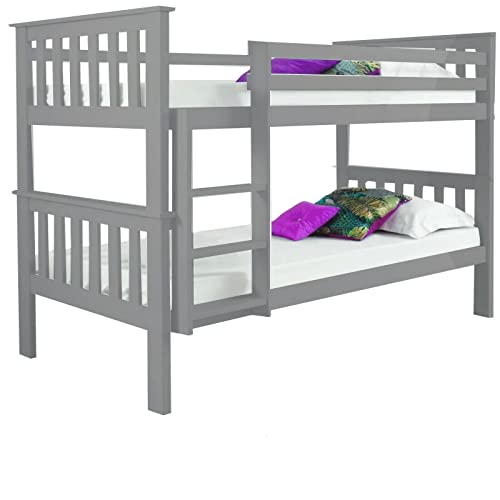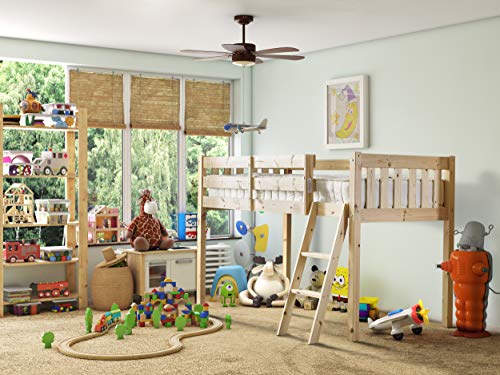Safety Considerations When Buying Kids Beds Bunk
 Bunk beds are an excellent way to save space and add a fun element to the room of a child. If a bunk bed isn’t well-designed, it could be a danger to safety.
Bunk beds are an excellent way to save space and add a fun element to the room of a child. If a bunk bed isn’t well-designed, it could be a danger to safety.
 Be sure to stop horses, and avoid hanging items from the top bunks (like jump ropes or scarves) and make sure that the ladders you have attached are safe. Continue reading to learn how to create a bunk bed for kids that will last.
Be sure to stop horses, and avoid hanging items from the top bunks (like jump ropes or scarves) and make sure that the ladders you have attached are safe. Continue reading to learn how to create a bunk bed for kids that will last.
Safety
When it comes to kids beds bunk, safety should be a top concern for parents. A bunk bed that meets the standards for safety in the United States can reduce the risk of injury. Also, ensuring that children are watched while they sleep as well as the enforcement of safety standards can reduce the risk of accidents. Finaly, ensuring that bunk beds for kids are properly assembled and maintained can reduce the risk of accidents.
The most frequent cause for injuries in kids bunk beds is falling off the top bed. It is important to install guardrails on the sides of the bed’s top to avoid this. They must be elevated at minimum 5 inches above the mattress’s surface to prevent accidental falls.
It is crucial to make sure that the railings are not loos or gapped and the space between them is small enough to prevent a child’s head or limbs from being trapped. In addition, it’s a good idea to use a mattress that fits comfortably within the frame of the bunk bed to prevent gaps that could create the risk of entrapment.
It is also recommended that parents supervise children on the upper bunk, and show them how to climb the ladder. It is also an excellent idea to eliminate any obstructions or tripping hazards from the vicinity of the ladder and top bunk access point, in addition to discourage jumping or rough play on the bed.
In general, it is best bunk beds to only allow one child to sleep in the top bunk. Children who are less than six years old older aren’t yet able to navigate the ladder in a safe way. It is recommended to inspect your bunk beds usa bed frequently to look for loose parts or damage that requires tightening. Also, ensure to follow the weight limits set by the manufacturer on the top and lower bunks. It is also important to avoid adding unnecessary components to the bed since they could weaken the bed’s structure and increase the likelihood of an accident.
Design
Created to make space in children’s rooms Bunk beds can also be an excellent way to make an area for play, a study zone or even a bedroom. Children love sharing their rooms with their siblings So why not make it more exciting by putting up a bunk bed? A standard bunk bed allows one child to sleep on the top and the other to sleep below. You can also look into a loft style bunk bed that incorporates a staircase or banister. This improves accessibility and makes sure that toddlers are able easily reach the top bed. This is a great option for small bedrooms. It can also be converted into two single beds when your children grow older.
Many best rated bunk beds beds come with built-in shelves and drawers that can be used to store books, toys and clothing. The addition of these storage options makes it easier for children to keep their bedrooms neat and tidy. They can also be used to store bedding and other items and ensure that your children will always have clean sheets for sleepovers. If you do not have space to accommodate these extra storage options you can put an assortment of freestanding bins near the bunks as an easy and efficient solution.
A neutral-colored bed is a fantastic option for any room for children. It can also be easily adapted as the child gets older. It’s easy to match with a variety of furniture for bedrooms and is a great choice for a contemporary or modern home. It’s a timeless design that will never fade out of fashion. This bed will be the ideal choice for kids who will use it for many years.
Consider a wood finish with elegant design if want a bunk bed to look stunning in the room of your child. This bed is a classic design that will blend in with any decor, and is an ideal option for families with smaller bedrooms or who have lower ceilings. On our page of collections you can pick from a wide selection of bunk beds made from wood with different sizes, heights, and entrance styles (ladders or stairs) as well as the colors and finishes.
Stability
One of the most important aspects to consider when purchasing kids bunk beds is stability. The design of the bed and the materials used contribute to this, with cheaper wooden frames more likely to move and fall over than metal ones. The stability of the bed is enhanced by ensuring that the ladder is attached to the bunk and is at a height that is safe for children to climb.
Another safety consideration is the presence of guardrails on both sides of the top best bunk bed to reduce the risk of falling. They should be set at least five inches above the mattress surface and checked regularly for damage or faulty installation. The mattress should be designed to fit snugly into the frame. This will help prevent gaps that could cause trapping. Finally, it is a good idea to consider the mattress’s capacity to bear weight, anticipating potential growth and change in body weight over time.
Check for loose or missing screws on your bunk bed on a regular basis. It’s especially important if your children are using the bunk beds, as they can easily dismantle the bunks or move them if they feel restless.
It’s also a good idea to have furniture anchors installed on the wall. These can be attached to bunk beds and furniture to keep them from falling over. They are easy to install, and they are a great way to increase your child’s safety.
Make sure your child is at least six before letting him or her sleep on the top bunk. This is the time when they’ll be able to climb up and down the ladder without assistance. If you have children who are younger it could be a better idea to look into a bunk bed or corner loft, which can be separated into separate beds to ensure that your children don’t fight over the top bunk each night.
Stores
A bunk or loft bed is a unit that consists of at least two beds, stacked one on top of the other. It’s an exciting way to make the most of the floor space, and also offer many storage options, from under-bed drawers to stairs that double as shelves. These pieces are available in different designs, finishes, and configurations that will fit in with any room for children. You can find furniture that can be divided into full-size and twin bed pieces for flexibility as your child grows.
The right bunk for kids with storage could transform the bedroom into a fun castle tower or a cosy place to play and nap. It can also transform the bedroom into a space where children can learn to be organized and keep their space neat and tidy. These aren’t just storage beds which only provide an open space at the bottom. They usually come with built-in shelves or drawers to help keep them organised and free of clutter.
Some models also include an escalator that offers an alternative way to climb up to the bed. This is a great choice for children who are not strong enough to climb the ladder themselves. Others have a front and an end ladder for added convenience, so you can choose which route makes more sense according to the layout of your child’s room.
If you’re not sure if your kids are ready for a bunk, consider an alternative bed called a loft. These higher-up pieces can still save valuable floor space and can be equipped with a desk or shelves to make it a complete storage and study solution. This Maxtrix loft bed known as the Star is a great example of this. It also comes with a desk that can be used as an office or a play area for kids bedroom furniture who are creative, with shelves on either side to store books, toys and other items.
In addition to safety concerns other important aspects to consider when choosing a loft or bunk bed for kids are the materials and style. Avoid cheap or flimsy bunks that can break easily. Instead, choose sturdy metal and wood frames. Make sure that the bunk has been tested by a third party to ensure it is up to or above the international and national standards for structural integrity, stability and lead content.
